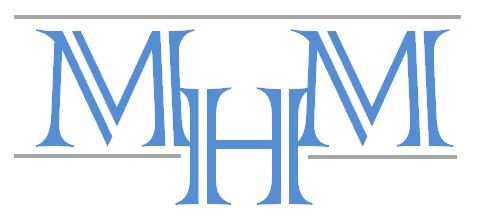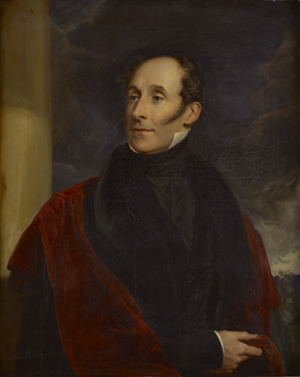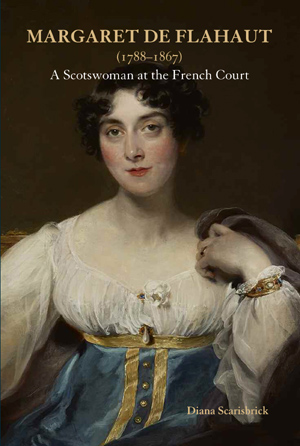MARGARET DE FLAHAUT
(1788–1867)
A Scotswoman at the French Court
Diana Scarisbrick
|
Obtainable from any good bookseller or from:
 |
John Adamson:
90 Hertford Street
Cambridge CB4 3AQ, UK
e-mail: Book orders
Book order form
|
Distributed in the United States and Canada by: |
ACC Art Books, New York
|
Distributed in Japan by:

| MHM Limited
1-1-13-4F Kanda Jimbocho
Chiyoda-ku, Tokyo 101-0051
Japan
+81 (0) 3 3518 9181
e-mail: Book orders
|
|
|
|
Margaret Mercer Elphinstone (1788–1867), with her powerful mind and independent spirit, was never daunted by adversity as she
sought to realize her ambitions for her family against the background of intellectual upheaval and social and political change which followed
the French Revolution and the end of the ancien régime. The turning-point in her life was her controversial marriage in 1817
with the general Charles de Flahaut (1785–1870), which, contrary to all expectations, resulted in one of the most successful
partnerships in the ‘auld alliance’ between France and Scotland.
Margaret was also a skilled draughtswoman and painter. Eight of her colourful portrait miniatures are featured in the book:
Charlotte, Princess of Wales; Leopold, Prince of Saxe-Coburg; Lord Byron; Charles de Flahaut; Peter Robert Drummond-Burrell;
Clementina Sarah Drummond-Burrell; Anne Elphinstone; and Dorothea, Princess Lieven.
|
top
The political and social worlds of France, England and Vienna during the period which began with the French Revolution and ended with the Second Empire are engagingly seen
through the eyes of a highly intelligent Scotswoman, Margaret Mercer Elphinstone, comtesse de Flahaut.
Whereas the life of her husband, the dashing Napoleonic general and diplomat Charles de Flahaut, is well known, Margaret has remained in the
shadows. Yet this biographical study, based on unpublished and intimate correspondence in the Archives Nationales, Paris, reveals her to have
been the more interesting of the two. It shows how much he depended on her brains, political judgment and artistic taste as well as her fortune
to guide him in his career. More than that, their letters to each other also confirm that she made a success of her controversial marriage and
that the bond between them was strengthened through all the vicissitudes of their life together. A faithful and sincere friend, she could be an
implacable enemy: Talleyrand’s companion, the duchesse de Dino, whom she dubbed ‘that horrid little serpent’, and the Duke of
Wellington, ‘that bully’, were favourite targets.
Her lively, observant but wicked pen takes us with her on visits to Talleyrand at Valençay, to the marquis de Lafayette, to the duchesse de
Praslin at Vaux-le-Vicomte, to house parties in stately homes of England and Scotland – Arundel, Woburn, Bowood, Chatsworth, Grimsthorpe
and Drummond Castle. Acknowledged a superb hostess, her descriptions of the menus, and entertainments organized in her homes in Scotland,
London, and Paris and at the Flahaut embassies in Vienna and in London capture the flavour of those cosmopolitan gatherings. Her guests were
also drawn to the display of her fine French furniture and collection of works of art, acquired during her years in Paris, which set a new
fashion in decoration. Interesting, too, are her accounts of sightseeing in Rome before the city of the Grand Tour changed into the capital of
united Italy. The enjoyable social life in the continental watering places is also described, for Margaret believed in the curative effects
of spas.
A lifelong liberal in politics and an upholder of Whig principles, her politicomanie inspires sharp comments on the opponents of Reform in England and on the
self-seeking ministers of Louis-Philippe in France. Unusually, for a British woman, the daughter of Admiral Keith, an inveterate enemy of the French, she shared her
husband’s admiration for Napoleon and joined with him in supporting Napoleon III.
Born before her time she could have made a name for herself in today’s world as a professional artist or politician in her own right. As it was, she used her
talents to become an expert in the art of living the life so amusingly and vividly evoked in letters to her husband, her children and her close friends.
These relationships, which are the heart of the book, are presented to the reader by an English woman historian, herself a Francophile.
|

Charles de Flahaut (1785–1870),
portrait by George Hayter (1792–1871)
© Mercer-Nairne: with permission
|
‘There is a little novel going on – Miss Mercer affichera
desperate love for Flahaut which he acts a most assiduous
return to but is really épris with Lady Cowper.’
Lady Harriet Granville, 3 February 1816
==============================================
‘[In this biography, Diana Scarisbrick, a leading scholar of jewellery and gems, may be seen] exploring another
of her great interests, French political and cultural life in the 19th century’.
Daily Telegraph, obituary notice, 6 February 2025
‘This volume, complete with color plates and a gold ribbon bookmark, reminds us that
once books were highly desired objects and once people expressed their ideas thoughtfully
in the lost art of letter writing.’
Helen Mitsios,
Wonderlust, October 2020
‘Diana Scarisbrick tells Margaret’s story expertly and elegantly
in this sumptuously produced and illustrated book. She evokes
a fascinating world peopled by a cast of striking individuals—including one of the most terrifying mothers-in-law
in history, the marquise de Souza.’
Munro Price,
The Art Newspaper, no. 318, December 2019
‘An . . . extraordinary story . . .’
The Victorian
‘[T]his surprisingly easy to read book is a great way to learn more about a very complex period in the history of Europe.’
Meikleour Arms, Meikleour, Perthshire
‘Much new information on Princess Charlotte (from whom she received 575 letters), the Duc d’Orleans, son of Louis Philippe, and Napoleon III, and their households, as well as on her husband, Napoleon’s favourite ADC, Charles de Flahaut.’
The Society for Court Studies
| |
top
|
1
2
3
4
5
6
7
8
9
10
11
12
13
14
15
16
17
18
19
20
21
22
| The Admiral’s Ambitious Daughter
Friendship with Princess Charlotte
Margaret’s Man Friends and Suitors
Charles de Flahaut before his Marriage
Charles in England: November 1815–December 1816
A Mutual Attraction
Weathering the Storm
Early Married Life in Scotland
Country Life in Scotland: Meikleour and Tulliallan
The Great World: Paris I
Home and Garden: Paris II
The Orléans Monarchy: Paris III
Margaret and Talleyrand
Margaret’s Friendships
Margaret’s Travels
Margaret’s Cult of Napoleon
The Vienna Embassy I, 1841–8
The Vienna Embassy II
London, 1848–64
Tulliallan and the London Embassy, 1848–64
The Final Phase: Paris I
The Final Phase: Paris II
Epilogue
Notes
Bibliography
Picture Credits
Index
Acknowledgments
|
|
top
|
Diana Scarisbrick, FSA (1928–2024), was a historian specializing in jewellery and engraved gems.
She curated exhibitions in the United Kingdom and abroad and wrote many books, including, more recently, Rings: Jewelry of Power, Love
and Loyalty (2007) and Portrait Jewels: Opulence and Intimacy from the Medici to the Romanovs (2011). For many years she was the
historian of Chaumet, the great Parisian jeweller. As research associate at the Beazley Archive, Oxford, she collaborated with Professor Sir
John Boardman and Claudia Wagner on The Beverley Collection of Gems at Alnwick Castle (Philip Wilson Publishers, 2016). In 2014 she
published with Benjamin Zucker the biography of Elihu Yale (Thames & Hudson). Among her last books were Diamond Jewelry: 700 Years of Glory and
Glamour (ISBN 978-0-500-02150-7) published by Thames & Hudson in September 2019, and the two volumes devoted to the Griffin collection of rings and
published by Paul Holberton in 2021 and 2024.
Also of interest:
Diana Scarisbrick’s essay “George IV and Jewellery” in Christopher Hartop (et al.),
Royal Goldsmiths: The Art of Rundell & Bridge, 1797–1843
(John Adamson in association with Koopman Rare Art, 2005)
|
top
|
Contact the
publishers or local agents for further information: Enquiries
|
top
|
Please print off the order form and
send it by mail to John Adamson, 90 Hertford Street, Cambridge CB4 3AQ, England.
|
top



